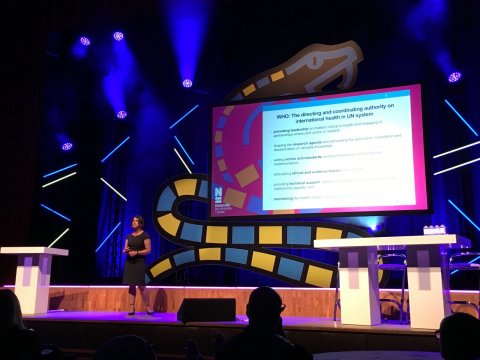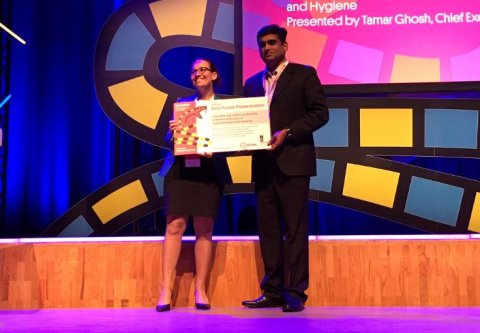Building collaborative momentum to fight snakebite

We recently returned from one of the first global gatherings about snakebite, in Leiden, Netherlands.
Up to 138,000 people a year die of snakebite and 450,000 people who survive suffer permanent injury or disability, so this is a topic that deserved this concerted focus from WHO, governments, NGOs, researchers, clinicians and representatives of industry.
By the end of the two days we felt as though a tide had turned, the renewed commitment from WHO in including snakebite in its list of neglected tropical diseases seemed supported by an explosion of plans and excitement, as we now move to issue the first draft of the roadmap for snakebite.
This has three objectives – to empower communities and health systems, to tackle snakebite effectively, to provide safe and effective treatment and to form a global coalition.
At the meeting we heard about some of the gaps to achieving this currently – a lack of data, infrastructure, safe and affordable anti-venoms, knowledge of the issue and correct treatment.
As we heard from WHO’s Bernadette Abela-Ridder, one of the most challenging aspects of snakebite is its relative burden on poor communities and hence the need for it to be viewed in the context of the Sustainable Development Goal targets.
The snakebite burden is not just the disease itself but also the lost income and lost education which, as result, renders it “a proxy for poverty”.
However, the meeting also shone some light on progress being made in field, a commitment to collaboration between partners and an increased momentum to push this as an important issue in the world of tropical medicine and global health.
The mere fact that an event on snakebite took place is a huge step forward for what Professor David Warrell, of the University of Oxford, has called the most neglected of all neglected tropical diseases.
RSTMH was pleased to be there as a partner organisation, as snakebite is one of our priority areas in our current strategy and will feature fairly prominently in our Annual Meeting later in the year.
Saving snakes, conservation, improving snake-human relationships
“Deep-seated fears may be the single greatest threat to snake conservation, as this fear challenges our ability to rationally and effectively manage the global threat of snakebite” Erika Nowak, Northern Arizona University
Royjan Taylor, from bio-Ken snake farm in Kenya also spoke on this topic. Through his organisation and snake farm, he is trying to change attitudes towards snakes.
Snakes are still killed, mostly due to fear, even when prohibitive/preventative laws exist. For example, although pythons are protected in Kenya, people still kill them. To raise awareness of the problem, he set up the Saving Snakes Facebook page.
Taylor stated that it’s difficult to call for snakes to be saved when snakebite is such a big issue. This is more complex when we consider the role of snakes in some parts of the world to keep rodent populations down, thus optimising agricultural outputs. One way of remedying this is to go to communities with pictures of venomous snakes and educate people. He recommended that big snakes need to be relocated.
Public education for prevention

This leads us to the next big topic of the conference; public education. Over the course of the meeting we heard about the importance of education for doctors and other health workers to be able to properly know what treatment to administer. It is also important for communities to know what to do and avoid doing in the immediate aftermath of a snakebite.
It was interesting to hear Jorg Blessman from the Berhard Nocht Institute of Tropical Medicine talk about his experience of snakebite in South East Asia.
As an internal physician new to the region, the first time he received a patient bitten by snake, he and his team had no idea how to treat it, no anti-venom and found out the patient had already had been treated by a traditional healer. We heard how traditional healing and witchcraft are used by quite a few communities as the first port of call for treatment, wasting valuable time, as a result of very embedded religious, spiritual and cultural practice.
He realised that, as well as a reliable stock of anti-venom, educational materials were needed. He developed a brochure about snakebite treatment and prevention, as well as a 1.5-day workshop for medical staff.
Anita Malhotra from the University of Bangor spoke of the burden of snakebite in India. Despite there being dedicated educators, there are not enough to cover such a huge population. At the moment, anything to do with snakebite education is extra-curricular and is reliant on willingness of schools to take it on. Her view was that education boards need to be lobbied so that snakebite education is embedded into syllabuses.
Part of the education strand of the talks looked at how the community of snake rescuers has been hijacked by social media content creators, who engage in high risks stunts which often result in fatalities.
An interesting take on the education angle came from Robin Bernard of the National Snakebite Initiative India. He proposed that successful programmes should involve the community and one of the best ways to do that is through mobile phone games and apps.
The gap between toxicology and practical considerations exists and there was a call for more translational research in the topic.
Anti-venom research
However effective education and prevention programmes are though, people sadly will still get bitten by snakes, meaning that we need accessible, affordable and effective anti-venoms. These are, in all respects, severely lacking.
MSF’s Julien Potet gave an account of his narrative review of the clinical data for safety and effectiveness of snakebite antivenom products available in African markets.
The outlook was a little bleak with volatile markets, poor regulations and geographically inappropriate anti-venoms are often unscrupulously marketed. However, the conclusions were that there is a dearth of clinical data on anti-venom products currently used in sub-Saharan Africa. Potet went on to say that it is unacceptable that some anti-snake venom products are in the market despite the lack of any positive clinical data.
Jose Maria Gutierrez from the University of Costa Rica, in his excellent talk on snakebite in Latin America, discussed the fact that researchers are often disconnected from antivenoms manufacturer, regulators and clinicians and need to better foster these links.
WHO policy – the path ahead

This call for collaboration and cross-disciplinary working was very strongly felt when Bernadette Abela-Ridder from WHO took to the stage to talk about the planned WHO roadmap.
Their role, she said, was to reach people who are most exposed to snakebite – as part of WHO’s “leave no one behind” policy. Part of their role is also to work with manufacturers and countries to improve availabilities of products.
She was positive that snakebite is one NTD where progress is happening with little financial resources. Much of that is down to the passionate people who are fighting the financial, physical and mental impact of snakebite.
She highlighted the potential in the synergies across tropical medicine – that bed nets can potentially prevent malaria and snakebite, that shoes can prevent a multitude of diseases, that improved wound care benefits everyone, as does educating health workers on the frontline and building a solid evidence base. Lessons learned from stockpiling, as in other disease areas would also be beneficial for snakebite.
Roadmap and resolution
Dr David Williams from the University of Melbourne turned to the key objectives of WHO’s roadmap for the prevention, reduction and control of snakebite envenoming: safe and effective treatment, target communities and health systems and build a global coalition.
The solutions must focus on snakebite victims, anti-venoms must be better regulated, and education, prevention and treatment must start at the community level.
He then made a rallying cry to us all:
“If snakebite falls off WHO’s NTDs list again, nothing will ever happen. It fell off once before because, once it was added the first time, the snakebite community sat back and didn’t offer WHO the technical support it needed. Now is the chance to make a big change. We all need to put our heads together and figure out how to help WHO.” This is important for some of our most marginalised communities".
Using crowd-sourcing for mapping venomous snakes in India
We were delighted to present the award for best poster of the conference. The audience-voted winner was Jose Louies from the organisation Indian Snakes. The poster demonstrated an innovative crowd-sourcing methodology to locate and map snakes.
Jose received a year’s free RSTMH membership – we welcome him to our community of people working to improve tropical medicine and global health across the world.
Next steps
As the meeting ended, the mood was extremely positive. It felt that this was a starting point from which to build momentum and initiate collaborative work.
Dr Rob Harrison from Liverpool School of Tropical Medicine wrapped up by saying the way forward was to “gather and make use of the data. That’s the challenge, but that’s how we progress.”
There is clearly a need for more creative and comprehensive ways to map venomous snakes and also snakebites, to build learnings to short cut treatment pathways and provide more accurate demand for specific antivenoms.
From our point of view, it was great to talk about how we can help leverage snakebite to the next stage of awareness, perhaps with the help of an international day where collaboration and coordinating focus can deliver a few objectives at once.
